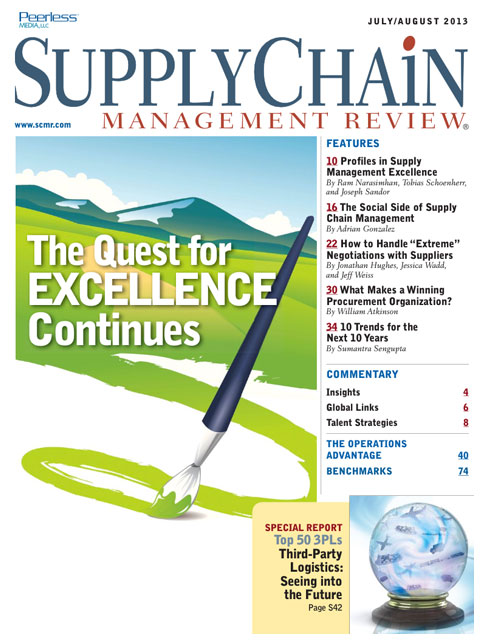Sorry, but your login has failed. Please recheck your login information and resubmit. If your subscription has expired, renew here.
July-August 2013
How do you extend the frontiers of supply management excellence and build a solid competitive advantage? Answers to this pivotal question emerged from an Executive Summit of supply chain leaders convened recently at Michigan State University. The four companies profiled here, all participants in that summit, have adopted principles that promote excellence and continue to expand that frontier. Browse this issue archive.Need Help? Contact customer service 847-559-7581 More options
In 2010, Jeff Weiss and Jonathan Hughes, together with Major Aram Donigian, published an article in the Harvard Business Review entitled “Extreme Negotiations.” That article explored lessons from the U.S. military about negotiating in high-stakes, high-pressure situations—lessons with potential relevance to complex negotiations in the business world. A key insight underlying the ideas from the article is that negotiation behaviors tend to be deeply ingrained and are often reactive rather than deliberate, especially under conditions of significant stress. By carefully analyzing how military officers in theater were often able to defuse dangerous situations, five replicable strategies emerged. Although these strategies differ from most people’s default reactions to stressful negotiating situations, the ability to implement them can indeed be learned.
This article is a companion to the Harvard Business Review piece, and addresses how the same approaches can be employed in especially challenging negotiations with suppliers. Over the past several years, we have helped sourcing and supply chain executives and professionals employ these strategies when traditional forms of leverage seemed unavailable (for example, with single and sole source suppliers), and/or when business-critical suppliers seemed to be engaging in opportunistic or even adversarial negotiation tactics. These strategies are not only useful at the bargaining table, but can (and should) also serve to reshape planning and positioning far in advance of formal negotiations.
Strategy 1: Broaden your field of vision, question assumptions, and re-think objectives.
Start by identifying key assumptions and subject them to scrutiny; use negotiation planning and execution to continually gather new information and revise strategies accordingly.
 |
This complete article is available to subscribers
only. Click on Log In Now at the top of this article for full access. Or, Start your PLUS+ subscription for instant access. |
Not ready to subscribe, but need this article?
Buy the complete article now. Only $20.00. Instant PDF Download.
Access the complete issue of Supply Chain Management Review magazine featuring
this article including every word, chart and table exactly as it appeared in the magazine.
SC
MR
Sorry, but your login has failed. Please recheck your login information and resubmit. If your subscription has expired, renew here.
July-August 2013
How do you extend the frontiers of supply management excellence and build a solid competitive advantage? Answers to this pivotal question emerged from an Executive Summit of supply chain leaders convened recently at… Browse this issue archive. Access your online digital edition. Download a PDF file of the July-August 2013 issue.
 |
Download Article PDF |
In 2010, Jeff Weiss and Jonathan Hughes, together with Major Aram Donigian, published an article in the Harvard Business Review entitled “Extreme Negotiations.” That article explored lessons from the U.S. military about negotiating in high-stakes, high-pressure situations—lessons with potential relevance to complex negotiations in the business world. A key insight underlying the ideas from the article is that negotiation behaviors tend to be deeply ingrained and are often reactive rather than deliberate, especially under conditions of significant stress. By carefully analyzing how military officers in theater were often able to defuse dangerous situations, five replicable strategies emerged. Although these strategies differ from most people’s default reactions to stressful negotiating situations, the ability to implement them can indeed be learned.
This article is a companion to the Harvard Business Review piece, and addresses how the same approaches can be employed in especially challenging negotiations with suppliers. Over the past several years, we have helped sourcing and supply chain executives and professionals employ these strategies when traditional forms of leverage seemed unavailable (for example, with single and sole source suppliers), and/or when business-critical suppliers seemed to be engaging in opportunistic or even adversarial negotiation tactics. These strategies are not only useful at the bargaining table, but can (and should) also serve to reshape planning and positioning far in advance of formal negotiations.
Strategy 1: Broaden your field of vision, question assumptions, and re-think objectives.
Start by identifying key assumptions and subject them to scrutiny; use negotiation planning and execution to continually gather new information and revise strategies accordingly.
 |
SUBSCRIBERS: Click here to download PDF of the full article. |
SC
MR

Latest Supply Chain News
- AI, virtual reality is bringing experiential learning into the modern age
- Humanoid robots’ place in an intralogistics smart robot strategy
- Tips for CIOs to overcome technology talent acquisition troubles
- There is still work to do to achieve supply chain stability
- Blooming success: The vital role of S&OE in nurturing global supply chains
- More News
Latest Resources

 Explore
Explore
Topics
Latest Supply Chain News
- AI, virtual reality is bringing experiential learning into the modern age
- Humanoid robots’ place in an intralogistics smart robot strategy
- Tips for CIOs to overcome technology talent acquisition troubles
- There is still work to do to achieve supply chain stability
- Blooming success: The vital role of S&OE in nurturing global supply chains
- Supply chain salaries, job satisfaction on the rise
- More latest news
Latest Resources

Subscribe

Supply Chain Management Review delivers the best industry content.

Editors’ Picks





